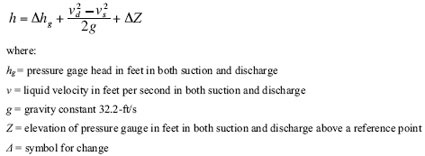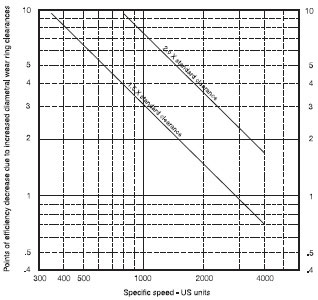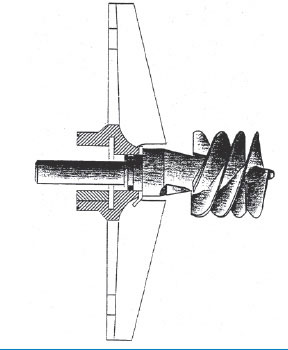Q. What are the most probable causes of insufficient discharge flow or pressure in centrifugal pumps?
A. Before looking at the pump, check the measurement of total head and rate of flow. The proper equation for total head h is:

Many users ignore the change in velocity head and elevation head which often makes a significant difference in the total head. See ANSI/HI 1.6 Centrifugal Pump Test for extensive detail on this subject.
Next, we should look at the pump system and check for the following:
- Air leaks in the suction piping.
- System head higher than anticipated (low flow and high discharge pressure).
- Insufficient NPSH available.
- Foot valve too small.
- Vortex at suction supply.
- Suction or discharge valve partially closed.
Finally, looking at the pump:
- Air leaks through the shaft seal or stuffing-box.
- Pump speed too low.
- Pump wearing rings worn (see Figure 1.78B).
- Damage to the impeller or internal blockage.
- Impellers loose on shaft (primarily multistage).
- Impeller installed backward ( primarily double suction).
- Wrong direction of rotation.

Q. We have a 100-hp end suction pump that has a broken shaft. What are the causes of shaft breakage?
A. Pump shafts usually break in the fatigue failure mode. High stress starts a small crack, which slowly progresses as each rotation of the shaft causes a fluctuation or reversal of the stress. The crack becomes larger until the final failure occurs.
The cause of the original crack can be from unexpected bending of the shaft. Coupling misalignment could be a contributor. Large radial forces from the impeller when operated near shutoff are another possible cause.
The original crack may start from a point of stress concentration such as a shaft keyway. The sharp corner in the keyway causes a stress riser in the shaft which progresses to a small crack and ultimately shaft failure.
In a similar manner, stress corrosion may begin in grooves or crevices or where impellers are mounted on the shaft. As corrosion proceeds, the useable area of the shaft is reduced and failure eventually results.
Excess power may also be a cause. When pumping liquids with high specific gravity, such as sulphuric acid, the normal power required by the pump is increased proportional to the specific gravity. The shaft may be designed to pump water but high specific gravity can cause an overload.
Finally, the shaft material may not meet the original specification. Replacement shafts may be procured from non-OEM shops which may not know when special materials are needed.
Q. What is an inducer and how does it work?
A. Inducers are single stage axial flow helixes installed in the suction eye of centrifugal pump impellers to lower the NPSHR of the pump (see Figure 1.79). This allows use of increased rotating speed for a given NPSHA or a lower NPSHR for a given speed. Shallow blade inlet angles are used to draw liquid into the inducer channels, which are shaped to impart enough energy to provide sufficient NPSH for the main impellers to avoid detrimental cavitation.

Whereas centrifugal pump impellers often have a suction specific speed, S, of about 8000 to 12,000, use of inducers can increase S to a range of 15,000 to 35,000. This typically allows lower flow pumps to operate at 11,000-rpm with the same NPSH, which would be required at 3600-rpm without inducer, or reduce NPSHR of all pumps to less than half at the same speed.
Cavitation damage of inducer blades may occur above certain experience-established inducer tip speeds. At lower tip speeds, cavitation will not produce damage regardless of S value. Allowable tip speed is also a function of inducer materials; e.g., titanium alloy is 20 percent higher than for stainless steel. Tip speeds may also be increased for lower specific gravity liquids.
Inducer flow range must be designed and selected to provide sufficient S over the intended operating range to avoid cavitation in the main impeller. Suction specific speed typically is reduced at low and high ends of inducer performance range.
Pumps & Systems, September 2007

